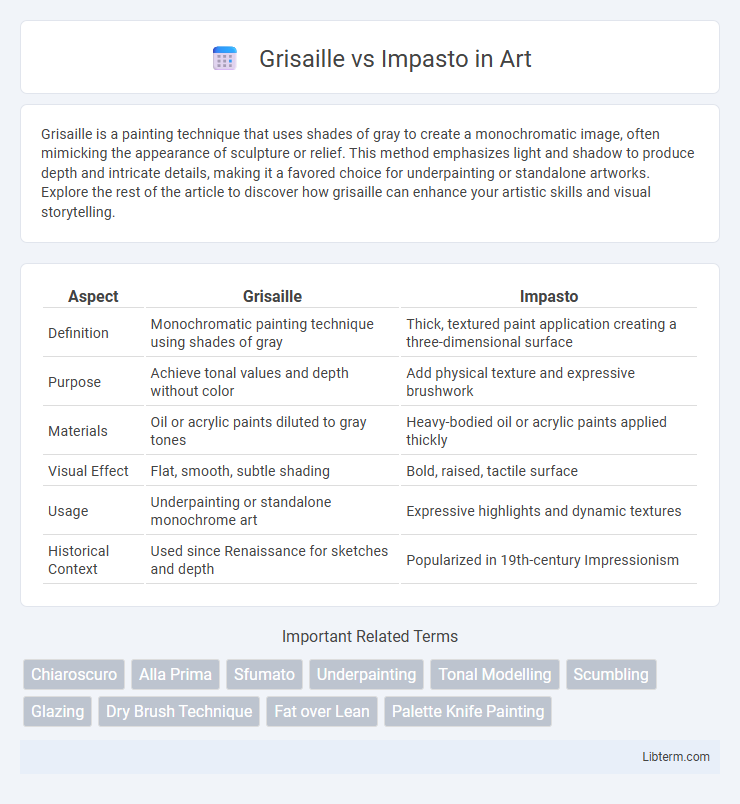Grisaille is a painting technique that uses shades of gray to create a monochromatic image, often mimicking the appearance of sculpture or relief. This method emphasizes light and shadow to produce depth and intricate details, making it a favored choice for underpainting or standalone artworks. Explore the rest of the article to discover how grisaille can enhance your artistic skills and visual storytelling.
Table of Comparison
| Aspect | Grisaille | Impasto |
|---|---|---|
| Definition | Monochromatic painting technique using shades of gray | Thick, textured paint application creating a three-dimensional surface |
| Purpose | Achieve tonal values and depth without color | Add physical texture and expressive brushwork |
| Materials | Oil or acrylic paints diluted to gray tones | Heavy-bodied oil or acrylic paints applied thickly |
| Visual Effect | Flat, smooth, subtle shading | Bold, raised, tactile surface |
| Usage | Underpainting or standalone monochrome art | Expressive highlights and dynamic textures |
| Historical Context | Used since Renaissance for sketches and depth | Popularized in 19th-century Impressionism |
Grisaille vs Impasto: Key Differences
Grisaille is a monochromatic painting technique using shades of gray to create a sculptural, detailed effect, often employed for underpainting or as a stand-alone artwork. Impasto, by contrast, involves applying thick layers of paint to produce texture and dimension, making brushstrokes visibly prominent on the canvas. These key differences highlight Grisaille's focus on tonal variation and subtlety versus Impasto's emphasis on tactile richness and expressive movement.
Historical Origins of Grisaille and Impasto
Grisaille, originating in the 14th century Gothic period, was primarily used in illuminated manuscripts and stained glass designs to mimic sculpture through monochromatic gray tones. Impasto emerged during the Renaissance, gaining prominence with artists like Rembrandt and later the Impressionists, who applied thick layers of paint to create texture and emphasize brushwork. Both techniques reflect distinct artistic goals: grisaille's historical use in detailed, subdued tonality contrasts with impasto's tactile and expressive surface effects.
Artistic Techniques Explained: Grisaille
Grisaille is a painting technique using shades of gray to create a monochromatic image that emphasizes form, lighting, and texture without color distraction. Often employed in underpainting or detailed studies, it allows artists to establish tonal values and depth before applying layers of color or glazing. Unlike impasto, which relies on thick, textured brushstrokes for dimensionality, grisaille focuses on subtle gradations and smooth transitions to achieve realistic chiaroscuro effects.
Artistic Techniques Explained: Impasto
Impasto is an artistic technique characterized by thickly applied paint that creates texture and depth, allowing brush or palette knife strokes to be visibly prominent on the canvas. This method enhances the tactile quality and dimensionality of a painting, often resulting in dramatic light reflection and shadow effects due to the raised paint surface. Unlike Grisaille, which is a monochromatic underpainting technique emphasizing tonal values, Impasto emphasizes physicality and expressive brushwork through its thick, textured layers.
Effects on Visual Perception: Depth and Texture
Grisaille creates a monochromatic depth by emphasizing tonal contrast and shading, resulting in a smooth surface that enhances the illusion of three-dimensional form with subtle gradations. Impasto builds physical texture through thick layers of paint, casting shadows and catching light to produce a tactile, dynamic surface that intensifies visual depth and movement. The interplay between the flat, nuanced tonalities of grisaille and the raised, textured qualities of impasto influences the viewer's perception of space and materiality in a painting.
Tools and Materials Used in Both Styles
Grisaille painting primarily uses black, white, and gray pigments applied with fine brushes on smooth surfaces like primed canvas or wood panels, often employing thin glazes to achieve detailed monochromatic effects. Impasto techniques require thick, heavy-bodied oil paints or acrylics that retain texture, applied with palette knives or stiff-bristled brushes to build up raised, three-dimensional surfaces. Both styles demand high-quality pigments, but Grisaille emphasizes smoothing tools like brushes and blending mediums, whereas Impasto relies on tools that allow for tactile, expressive paint application.
Famous Artists Embracing Grisaille and Impasto
Renowned artists such as Rembrandt and Diego Velazquez mastered grisaille techniques to create monochromatic underpaintings that enhanced depth and form in their works. In contrast, Vincent van Gogh and Jackson Pollock famously embraced impasto, applying thick, textured layers of paint to convey vibrant emotion and dynamic movement. These contrasting methods highlight the distinct approaches to texture and tonal expression in art history.
Grisaille vs Impasto in Modern Art
Grisaille and impasto techniques represent contrasting approaches in modern art, with grisaille emphasizing monochromatic, tonal variations that create a sculptural, three-dimensional effect on a flat surface. Impasto involves the thick application of paint, producing textured, dynamic surfaces that capture light and movement, contributing to expressive and tactile qualities. These methods serve distinct purposes: grisaille often underpins or enhances representational depth, while impasto foregrounds materiality and painterly expression.
Choosing Between Grisaille and Impasto for Your Work
Grisaille employs a monochromatic palette to create depth and form through subtle tonal variations, ideal for artists aiming for classical, precise underpaintings or sophisticated layering effects. Impasto uses thick, textured paint application to produce a three-dimensional surface with dynamic light interplay, perfect for conveying emotion and expressive brushwork in contemporary or abstract pieces. Selecting between Grisaille and Impasto depends on your artistic intention, desired texture, and the visual impact you want to achieve in your work.
Combining Grisaille and Impasto: Creative Possibilities
Combining grisaille and impasto techniques unlocks dynamic textural contrasts by layering monochromatic underpainting with thick, expressive strokes of oil or acrylic paint. This fusion enhances depth and dimension, allowing artists to emphasize form and light through subtle grayscale foundations beneath vibrant, heavily textured surfaces. The interplay between grisaille's controlled shading and impasto's tactile richness broadens creative possibilities, resulting in visually compelling and structurally complex artworks.
Grisaille Infographic

 libterm.com
libterm.com